A healthy torso has muscles that are developed symmetrically. Many people are unaware that their chest muscles are more conditioned than their back muscles. This asymmetry causes problems in their mobility, appearance, and alignment of their lower back. Fortunately, the best lower lat and back exercises solve these problems. See the video lower within this article and the printable list of exercises.
Create a Healthier, Better-Looking Back with Lower Lat Exercises
Too many people are skipping Back Day at the gym! This article provides an excellent workout to give you a sculpted torso. It targets your back muscles – especially your lower lat – and includes photos and descriptions of each movement.
These lower lat exercises are appropriate for both men and women. Additionally, each exercise can be modified to accommodate any fitness level – from beginner to advanced.
How Lower Lat Exercises Improve Your Appearance
The lat – or latissimus dorsi – is your upper physique’s most significant muscle.
The lower lat, in particular, is directly responsible for the aesthetically pleasing appearance of a healthy-looking torso.
This is because a developed lower lat makes the waist appear smaller by creating the V-shaped taper that is appealing to the human eye. This has been proven by science, by the way.
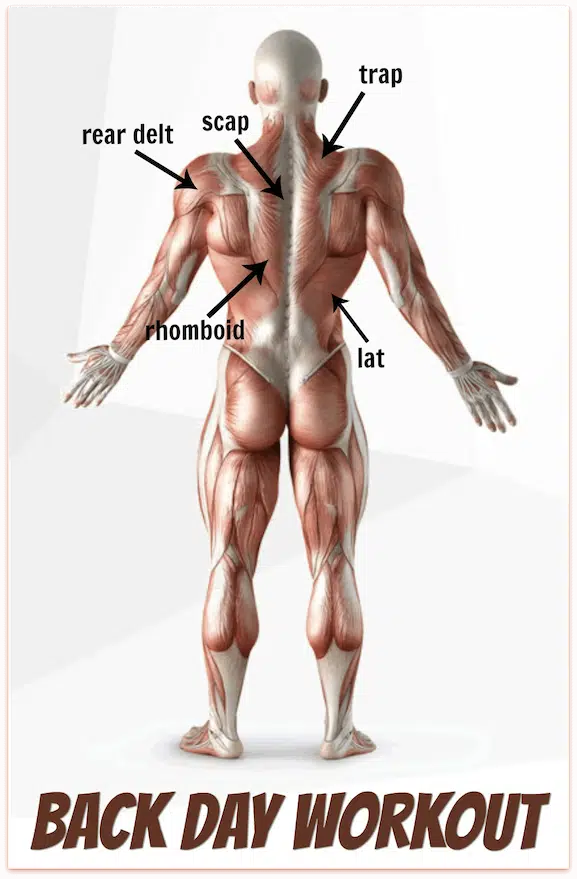
Research studies on physical attractiveness have established that what makes someone appealing at first glance is not their size, per se, but their proportions – including the shape of their silhouette between the waist and shoulders. The lower lat is the muscle area that helps create this distinction!
Stronger Lower Lat Muscles Are an Essential Ingredient of Good Health
If your torso has muscles that are more important than others, it would be your back muscles.
Back muscles are responsible for good posture and a tall spine.
The slouch many people have today results from weak back muscles that become over-stretched in a specific shape from texting, computing, and driving.
Strangely, even though strong lower lat muscles are an imperative component of good health, many people continue to train their chest muscles disproportionately.
Why?
Probably because that’s what they see first when they look in the mirror.
Also, it’s a bit simpler to train the chest rather than the lower lat, simply because less equipment is needed to push (chest) rather than to pull (back). For example:
- push-ups are a fundamental chest exercise, and beginners can always do push-ups on their knees.
- however, the fundamental back exercise – the pull-up – requires a high bar from which to pull (plus, beginners have a hard time pulling their own bodyweight and so require specialized equipment – or at least a resistance band attached to a high bar).
With a bit of creativity and an adventurous attitude, it’s possible to find fun ways to keep your back workouts interesting and effective.
Keep Your Torso Healthy and Attractive with this Circuit Routine for Your Lower Lat Muscles
The best exercise routine is the one you’ll actually do.
This circuit routine is designed not only to shape, define, and strengthen your lower lat area but also to burn a higher number of calories compared to a standard, vanilla weight training workout.
Plus, it’s a lot of fun.
Here’s what you need to know:
- Move through exercises in the circuit consecutively – without a break.
- Once you’ve finished a circuit, take a brief rest before repeating the circuit two more times.
- That rest period should be about 2 minutes – a bit less for advanced athletes and a bit more for beginners.
- Use a timer on your phone (or watch) to make certain you’re gauging time correctly (many of us tend to underestimate the amount of time we rest).
- After completing a circuit 3 times, move on to the next new circuit.
First Lower Lat Circuit:
The first circuit utilizes exercises that will increase your abdominal awareness – because you’ll need your core muscles fully engaged later – to do challenging exercises safely.
This circuit gradually raises your body temperature and lubricates the muscles and joints. Basically, it gets the blood moving.
Additionally, if you’re over the age of 50, I encourage you to do 6 minutes of light cardio before starting this workout. A brisk walk or a light jog – outdoors or on the treadmill – should do the trick.
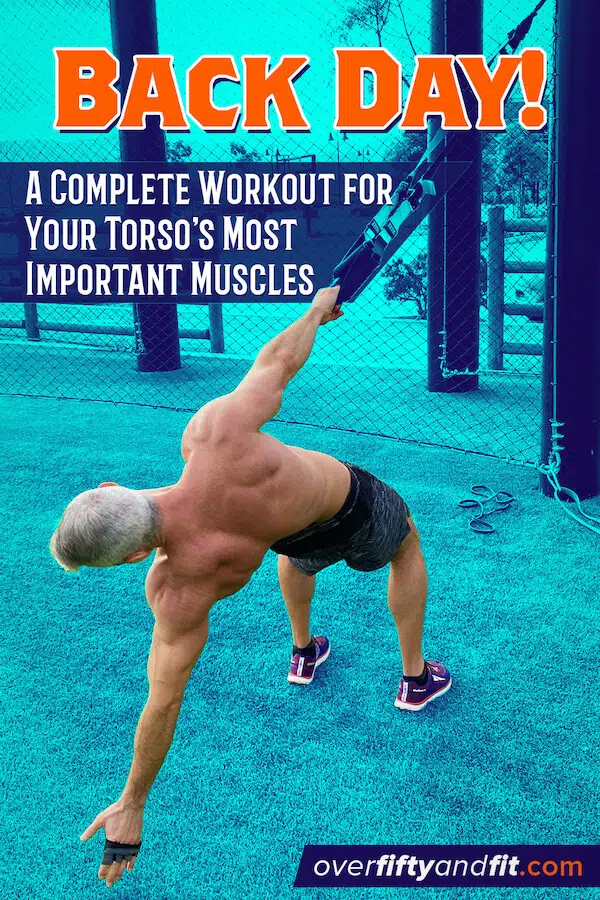
Reach-Back Single-Arm Suspended Row
To properly execute a single-arm suspended row movement, you begin by rotating your spine and reaching one arm back to touch the ground. Then you pull/row the arm holding the TRX strap – as you rotate the spine and return yourself forward, reaching up.
Resist the temptation to hold your breath.
You’ll feel your core muscles working – especially your obliques – as well as your rhomboids and lats (see the muscular anatomy chart above).
Do 12 repetitions on each side.
A good lower lat workout utilizes a variety of grips (wide, narrow), positions (high, low), and tempos (slow, fast). You’ll notice this workout provides them all.

Leaning TRX Back-Day High Row
The TRX straps use your body weight to provide resistance. This makes it easy to make the exercise either harder (place your feet way forward in front of your torso) or easier (place your feet almost underneath your shoulders).
Remember to drop your chin, so you’re not over-arching your back or straining your neck muscles.
This is a high row, so your elbows come to the center of your torso.
You’ll be tempted to use your biceps to do most of the work, but try instead to initiate the movement from your lats and rhomboids.
12 reps.
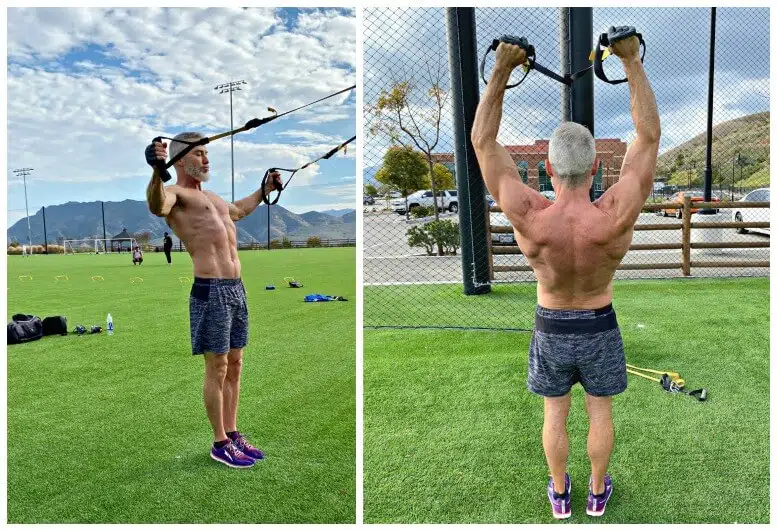
Alternating: Suspended Rear Delt Fly and Overhead Front Arm Raise
This is not a row; it’s a fly and a raise. That means the arms are almost straight but have a soft elbow bend.
The posterior deltoids cannot handle as much resistance as the lats and rhomboids, so for this exercise, you’ll want your feet almost underneath your shoulders.
16 reps (8 for each exercise).
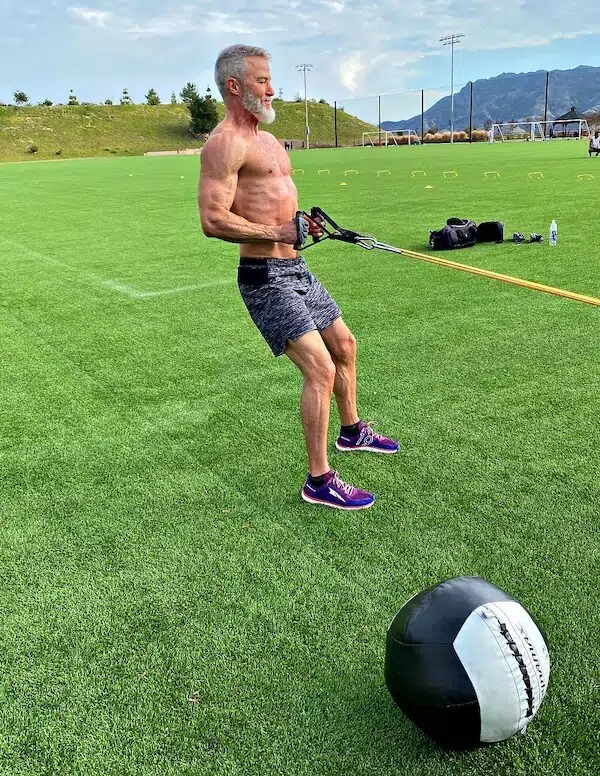
Low Row with Resistance Band for Lower Lat and Rhomboids
This is a low row, so your elbows come below the center line of your torso.
14 reps.
In the photos above, can you identify my lats, rhomboids, and erector spinae muscles? When those muscles become visible under the skin during a rowing exercise, you’re successfully engaging the lower lat area to pull, instead of just using the biceps to do most of the work.

Burpees with a Weighted Medicine Ball
Do a burpee keeping your hands on a big, weighted medicine ball, then in the standing position do an overhead press.
Beginners can do this exercise slowly. Advanced athletes can do it quickly.
14 reps.
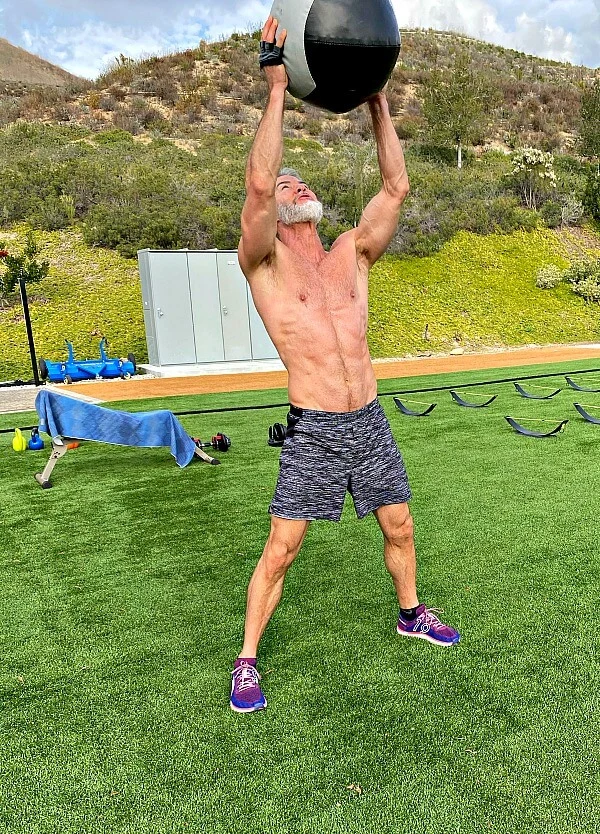
Final Lower Lat Circuit:
The posterior chain refers to those muscles on the backside of your body. This chain of muscles is often the missing link in many people’s training.
Let’s face it: we sit too much.
The exercises in this following circuit are explicitly programmed to correct problems associated with the modern sedentary lifestyle, including postural weaknesses that hinder our ability to look and feel our best.
Remember, by correcting muscular imbalances, we’re also likely avoiding future chronic pain. Everything in the human body is connected – either directly or indirectly – to everything else in the body. That means when imbalances are restored, hip, knee, or sciatica discomfort can also be remedied.

Horizontal Bench Dumbbell Rows for the Lower Lat
A classic rowing exercise. When you lean into the horizontal bench, keep your glutes active and your pelvis pressing forward into the bench. This will help protect your lower back.
12 reps.
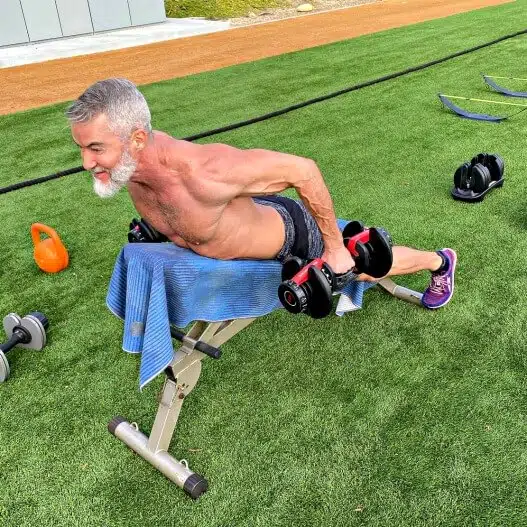
Arms-Close Rear Delt Dumbbell Flys for Upper Back
Similar to the row you just did, only this time, the arms are only slightly bent.
You’ll probably want to do a bit less weight than you did on the rows to concentrate on proper form and isolating those posterior deltoids (the rear delt muscles directly responsible for improving your posture).
12 reps.
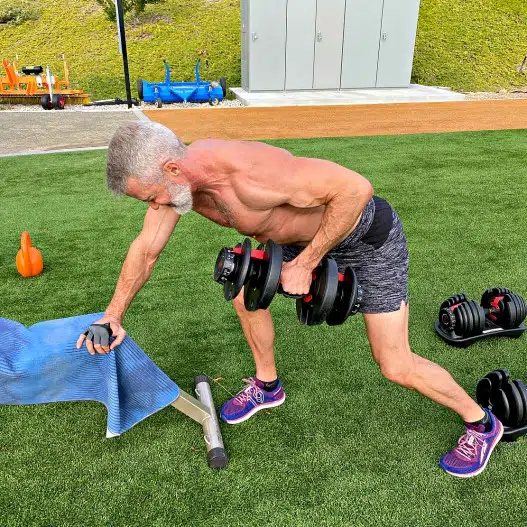
Alternating: Single-Arm Dumbbell Rows, Parallel and Perpendicular
- Remember to use your lower lat more than your arm muscles.
- Keep the core engaged!
- Hips should face down to the floor evenly.
- Let your breath flow freely.
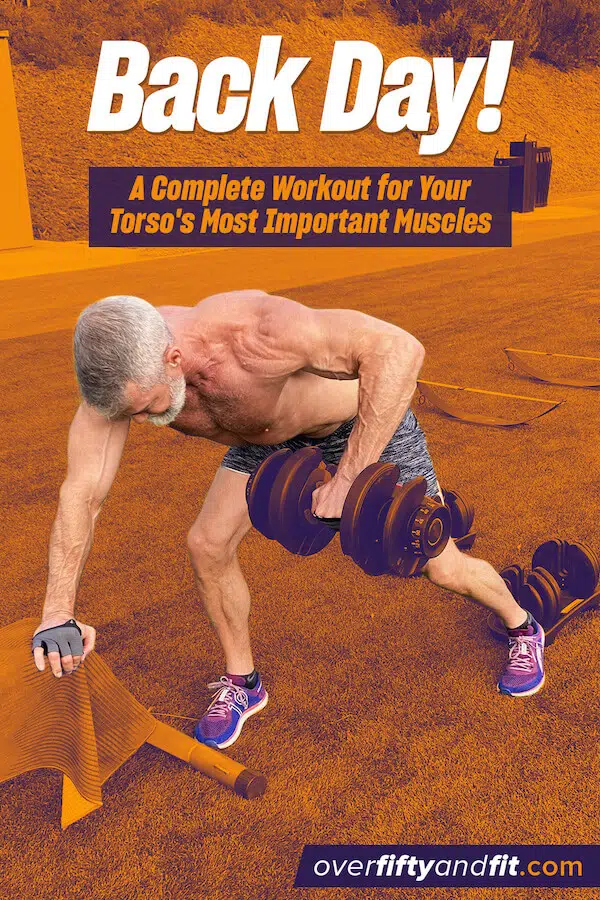
Tip: if you’re having a hard time finding good back isolation, try changing your grip. Sometimes, wrapping all five fingers around the dumbbell bar can trick your body into using lats more than biceps.
16 reps (8 per exercise).
Resistance-Band PullOvers for the Back
Resistance-band pullovers are an outstanding exercise because the resistance increases as the movement approaches the point of peak contraction.
16 reps.
Rope Slams
Slamming a battle rope is guaranteed to fill your lats with blood (“the pump”) and help give your torso that nice V-taper.
16 reps.
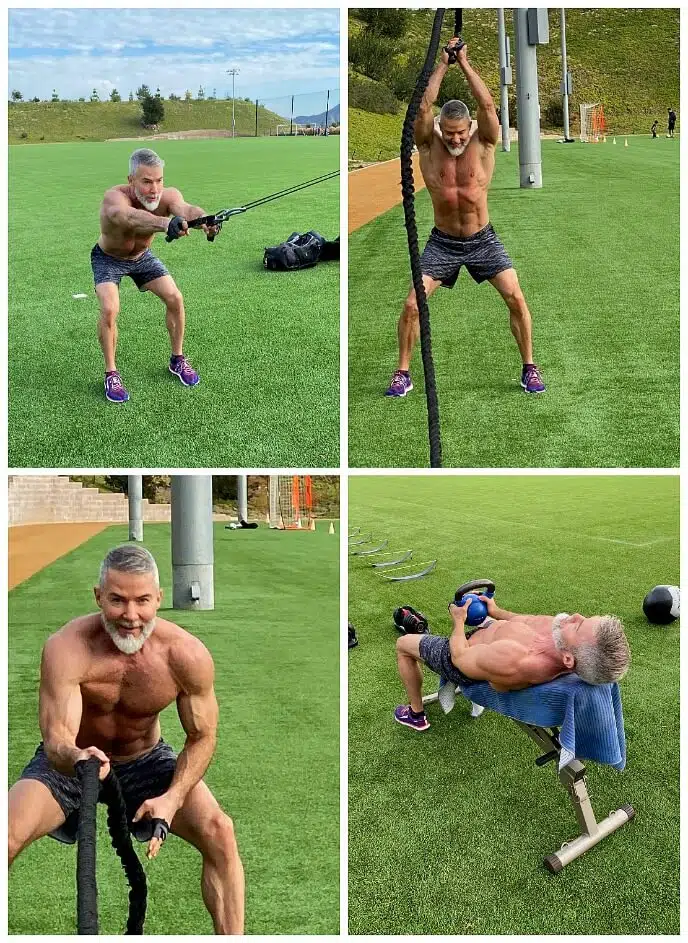
Battle Rope Tug-Of-War Variation for the Lower Lat
Grab a workout buddy to help you on this one. You pull one end of the battle rope while your buddy provides a bit of resistance on the other end, gradually making his or her way toward you (it’s not an all-out tug of war – you should “win” in the end).

How to Train Your Posterior Muscle Chain with Lower Lat Exercises
Don't skip Back Day at the gym! A healthy torso has symmetrically developed muscles. It's imperative to train your posterior muscle chain with lower lat exercises. Improve your appearance and avoid postural problems with this complete back workout.
Materials
- Optional: weight-lifting gloves to protect your hands.
Tools
- Equipment options include weighted medicine ball, kettlebell, bench, towel, dumbbells, TRX straps, and resistance band.
Instructions
First Circuit:
• Reach-Back Single-Arm Suspended Row
• Leaning TRX Back-Day High Row
• Alternating: Suspended Rear Delt Fly and Overhead Front Arm Raise
• Low Row with Resistance Band for Lats and Rhomboids
• Burpees with a Weighted Medicine Ball
Final Circuit:
• Horizontal Bench Dumbbell Rows
• Arms-Close Rear Delt Dumbbell Flys
• Alternating: Single-Arm Dumbbell Rows, Parallel and Perpendicular
• Resistance-Band PullOvers
• Rope Slams
• Battle Rope Tug-Of-War Variation
• Incline Dumbbell PullOver – Full Range of Motion
Notes
Here’s what you need to know:
- Move through exercises in the circuit consecutively – without a break.
- Once you’ve finished a circuit, take a brief rest before repeating the circuit two more times.
- That rest period should be about 2 minutes – a bit less for advanced athletes, and a bit more for beginners.
- Use a timer on your phone (or watch) to make certain you’re gauging time correctly (many of us tend to underestimate the amount of time we rest).
- After completing a circuit 3 times, move on to the next new circuit.
- During exercises, try to initiate the movement from your lower lats (otherwise your biceps will hog all the work).
Exercises can be modified to match your unique fitness level and circumstances. Ask your doctor first.
Incline Dumbbell PullOver – Full Range of Motion
Set a bench at a slight incline and, facing up to the sky, reach a dumbbell or kettlebell all the way back.
Use the power of your lats to bring the weight back over your chest.
This particular pullover is a full-range variation, meaning you bring the weight all the way down to your waist at the end of each rep. This also provides a highly effective negative resistance (“eccentric training”) for your pectorals.
Lower Lat Intelligence: Why Training Your Posterior Chain of Muscles is a Brilliant Idea
The principles of Foundation Training are born from the fundamental idea that when we move outside of the natural patterns for which our bodies were intended, then forces of gravity are absorbed by the wrong parts of the body, leading to instability, poor aesthetics, and – eventually – pain.

Hopefully, this lower lat workout will help strengthen and balance your body’s posterior chain of muscles so that they can support the weight of your body correctly.
The end result? That you look better and feel better!
Bonus Lower Lat Exercises
I’m an outdoors guy who lives in a year-round warm weather environment, so I like to workout outdoors whenever possible – as I have for the photos and videos within this article. However, there are even more lower lat exercises you can do inside the gym, including:
- reverse-grip, leaning-back cable pulldowns
- suitcase row
- close-grip cable rows with body angled forward
- straight-bar cable rows with underhand grip
- kayak rows
- cobra pulldown
- barbell rows and/or smith rows with a variety of widths and grips
- dead-stop dumbbell rows
- also, with cable rows and pulldowns, try varying the range of motion and/or doing single-arm variations instead.
Conclusion on Benefits of Lower Lat Exercises
Give these lower lat exercises a try. Remember to consult with your own medical doctor before undergoing any significant changes in your movement patterns or lifestyle habits.
Keep in mind that there are some anatomical realities that cannot be altered. For example, the insertion point of where a muscle actually begins in your body is genetically determined!
In my case, my lower lat begins many inches above my waistline. Meanwhile, I have friends with lower lat insertion points that begin at their waistline! These are simply genetic differences.
A healthy torso has symmetrically developed muscles. It’s imperative to train your posterior muscle chain, preferably once a week but at least twice a month. Improve your appearance and avoid postural problems with these lower lat exercises.
Additional Sources on Lower Lat Exercises:
Research: The Influence of Selected Torso Parameters – https://link.springer.com/article/10.1007%2FBF01542671
Importance of Training the Body’s Posterior Chain of Muscles, including the Lower Lat – https://www.foundationtraining.com/
